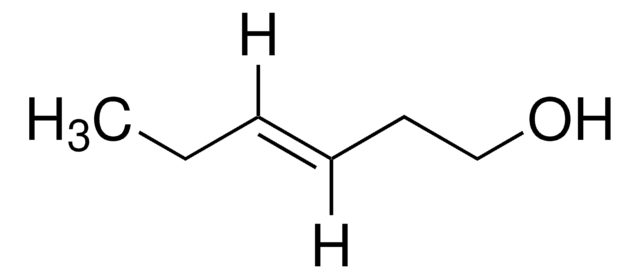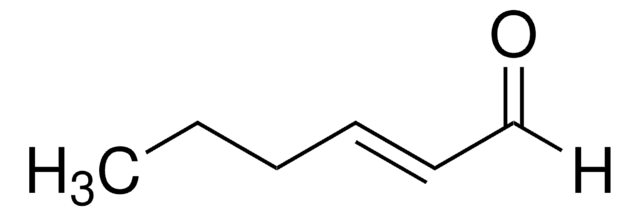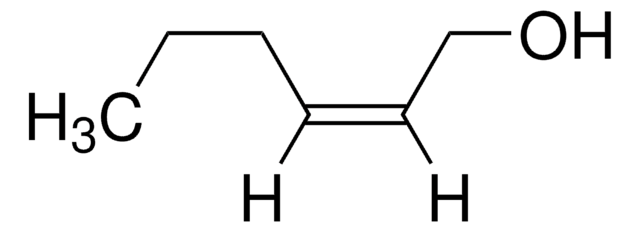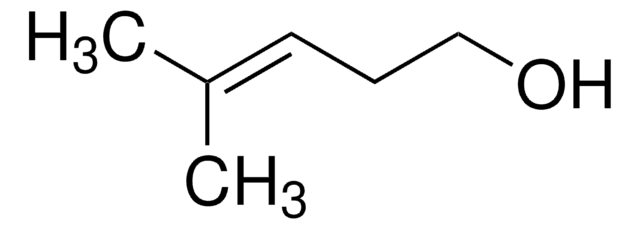224715
trans-3-Hexen-1-ol
97%
Synonym(s):
trans-3-Hexenol
Sign Into View Organizational & Contract Pricing
All Photos(1)
About This Item
Linear Formula:
C2H5CH=CHCH2CH2OH
CAS Number:
Molecular Weight:
100.16
Beilstein:
1719713
EC Number:
MDL number:
UNSPSC Code:
12352100
PubChem Substance ID:
NACRES:
NA.22
Recommended Products
Quality Level
Assay
97%
refractive index
n20/D 1.439 (lit.)
bp
61-62 °C/12 mmHg (lit.)
density
0.817 g/mL at 25 °C (lit.)
functional group
hydroxyl
SMILES string
[H]\C(CC)=C(\[H])CCO
InChI
1S/C6H12O/c1-2-3-4-5-6-7/h3-4,7H,2,5-6H2,1H3/b4-3+
InChI key
UFLHIIWVXFIJGU-ONEGZZNKSA-N
Looking for similar products? Visit Product Comparison Guide
General description
trans-3-Hexen-1-ol (trans 3-Hexenol) stimulates the antennae of male H. cunea moths.
Signal Word
Warning
Hazard Statements
Precautionary Statements
Hazard Classifications
Eye Irrit. 2 - Flam. Liq. 3
Storage Class Code
3 - Flammable liquids
WGK
WGK 3
Flash Point(F)
138.2 °F - closed cup
Flash Point(C)
59 °C - closed cup
Personal Protective Equipment
dust mask type N95 (US), Eyeshields, Gloves
Choose from one of the most recent versions:
Already Own This Product?
Find documentation for the products that you have recently purchased in the Document Library.
Customers Also Viewed
Rui Tang et al.
PloS one, 7(11), e49256-e49256 (2012-11-21)
Volatile organic compounds (VOCs) were collected from damaged and intact mulberry leaves (Morus alba L., Moraceae) and from Hyphantria cunea larvae by headspace absorption with Super Q columns. We identified their constituents using gas chromatography-mass spectrometry, and evaluated the responses
Peter de Groot et al.
Journal of chemical ecology, 34(9), 1170-1179 (2008-07-05)
Green leaf volatiles (GLVs) function as host attractants, pheromone synergists, or sexual kairomones for a number of coleopteran folivores. Hence, we focused on host GLVs to determine if they were attractive to adults of the emerald ash borer, Agrilus planipennis
Andre F Cruz et al.
Phytochemistry, 78, 72-80 (2012-04-24)
Fusarium diseases cause major economic losses in wheat-based crop rotations. Volatile organic compounds (VOC) in wheat and rotation crops, such as chickpea, may negatively impact pathogenic Fusarium. Using the headspace GC-MS method, 16 VOC were found in greenhouse-grown wheat leaves:
Shigehiro Namiki et al.
Journal of comparative physiology. A, Neuroethology, sensory, neural, and behavioral physiology, 194(5), 501-515 (2008-04-05)
Pheromone-source orientation behavior can be modified by coexisting plant volatiles. Some host plant volatiles enhance the pheromonal responses of olfactory receptor neurons and increase the sensitivity of orientation behavior in the Lepidoptera species. Although many electrophysiological studies have focused on
Gary G Grant et al.
Journal of economic entomology, 104(1), 173-179 (2011-03-17)
We conducted trapping experiments for the emerald ash borer, Agrilus planipennis Fairmaire (Coleoptera: Buprestidae) in Michigan, U.S.A., and Ontario, Canada, to compare unbaited light green sticky prism traps with traps baited with phoebe oil, (Z)-3-hexenol (Z3-6:OH), or blends of other
Our team of scientists has experience in all areas of research including Life Science, Material Science, Chemical Synthesis, Chromatography, Analytical and many others.
Contact Technical Service















